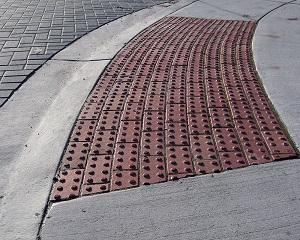Hazard warning surfaces
Contents |
[edit] Introduction
Hazard warning surfaces, also known as tactile paving, are textured ground surfaces that are used to assist pedestrians.
They come in a variety of forms and are commonly used in urban areas as a means of hazard warning for visually-impaired pedestrians at kerb edges, road crossings and gradient changes. They can also be used on cycle paths as a way of demarcating the area to be used by cyclists.
[edit] Blister tactile
Blister tactile surfaces are commonly used for pedestrian crossings with dropped kerbs, and consist of rows of flat-topped 6 mm-high domes or ‘blisters’ in a square pattern. For light-controlled crossings, blister paving should span the full width of the crossing, normally 0.8 - 1 m wide.
If the footpath is wider than 0.8 - 1 m, the paving should extended back by two or three courses to aid with detection.
Concrete or clay blister paving is usually provided in red, buff and ‘natural’ grey colours.
Stone blister paving can be used, with the blisters milled to a circular or square shape. This tends to be a more expensive option.
Metal ‘studs’ can be also be fixed to standard paving units, either by drilling and glueing or by using a high-strength adhesive or epoxy resin to fix them into position. Studs tend to be stainless steel with either a chromed or bronzed effect, and are retro-fitted once the paving has been installed. Studs can also be used as deterrence devices against skateboards and obstruction of access routes.
[edit] Offset blister tactile
This variation of blister tactile paving consists of ‘blisters’ spaced at 66.5 mm centres. These units are typically used to indicate the edge of off-street platforms in rail, tram and tube stations.
Any suitable paving material can be used to manufacture the paving units, and they are often coloured so as to contrast with the surrounding ground. The standardised layout of rail station platforms tends to mean it is easiest to use 400 x 400 mm or 450 x 450 mm pre-cast concrete units. The row of blisters must be parallel to the edge of the platform, and they are normally laid 500 mm back from the platform edge.
[edit] Lozenge tactile
This type of tactile paving is used for on-street platform edges, such as trams and bus stops. It comprises rows of around 6 mm-high lozenge shapes with rounded edges. They are usually buff coloured, but can be any colour. They should be installed to a depth of 400 mm parallel to the platform edge, and a minimum of 500 mm back from the edge.
[edit] Corduroy hazard warning tactile
This type of tactile paving comprises a rounded or rod-like surface protrusion which is often used:
- At the top and bottom of stairs.
- At the foot of a ramp.
- On a level crossing.
- Where a footway joins a shared route.
Rounded bars run transversely across the direction of pedestrian travel. The bars are around 6 mm high, 20 mm wide and spaced 50 mm from the centre of one bar to the centre of the next. They are typically made of pre-cast concrete, clay or natural stone.
[edit] Cycle way tactile
This tactile paving is intended to warn of cycle lanes, and is used on shared paving routes where the pedestrian side is not physically separated from the cyclist side. It comprises a series of continuous raised, flat-topped bars, each 5 mm high, 30 mm wide and spaced 70 mm apart. A central delineator strip should be made of a white material and be 12-20 mm high, 150 mm wide with sloping sides and a flat top of 50 mm.
[edit] Directional tactile
Also known as guidance tactile, this is intended to act as a guide across large paved spaces where a property line or kerb edge is not present. It can also be used as guidance around obstacles in a pedestrianised area such as street furniture.
It comprises a series of raised, flat-topped bars running parallel to the direction of travel. The bars are 5.5 mm-high, 35 mm wide and spaced 45 mm apart.
[edit] Related articles on Designing Buildings Wiki
Featured articles and news
Moisture, fire safety and emerging trends in living walls
How wet is your wall?
Current policy explained and newly published consultation by the UK and Welsh Governments.
British architecture 1919–39. Book review.
Conservation of listed prefabs in Moseley.
Energy industry calls for urgent reform.
Heritage staff wellbeing at work survey.
A five minute introduction.
50th Golden anniversary ECA Edmundson apprentice award
Showcasing the very best electrotechnical and engineering services for half a century.
Welsh government consults on HRBs and reg changes
Seeking feedback on a new regulatory regime and a broad range of issues.
CIOB Client Guide (2nd edition) March 2025
Free download covering statutory dutyholder roles under the Building Safety Act and much more.
AI and automation in 3D modelling and spatial design
Can almost half of design development tasks be automated?
Minister quizzed, as responsibility transfers to MHCLG and BSR publishes new building control guidance.
UK environmental regulations reform 2025
Amid wider new approaches to ensure regulators and regulation support growth.
The maintenance challenge of tenements.
BSRIA Statutory Compliance Inspection Checklist
BG80/2025 now significantly updated to include requirements related to important changes in legislation.
Shortlist for the 2025 Roofscape Design Awards
Talent and innovation showcase announcement from the trussed rafter industry.





























Comments
Could anyone suggest a company manufacturing the central delineator strip described under Cycle Way Tactile, meeting the requirements described in the article ("should be made of a white material and be 12-20 mm high, 150 mm wide with sloping sides and a flat top of 50 mm.")?